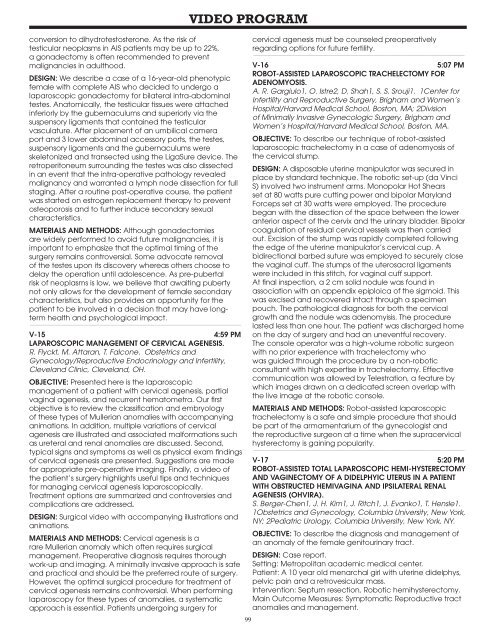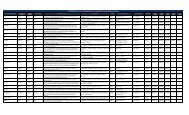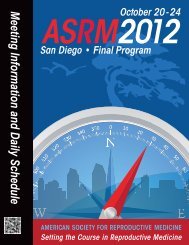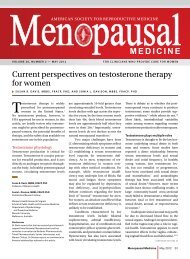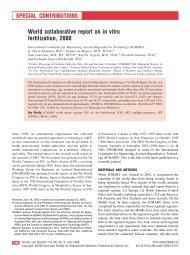scientific program • symposia - American Society for Reproductive ...
scientific program • symposia - American Society for Reproductive ...
scientific program • symposia - American Society for Reproductive ...
Create successful ePaper yourself
Turn your PDF publications into a flip-book with our unique Google optimized e-Paper software.
conversion to dihydrotestosterone. As the risk of<br />
testicular neoplasms in AIS patients may be up to 22%,<br />
a gonadectomy is often recommended to prevent<br />
malignancies in adulthood.<br />
DESIGN: We describe a case of a 16-year-old phenotypic<br />
female with complete AIS who decided to undergo a<br />
laparoscopic gonadectomy <strong>for</strong> bilateral intra-abdominal<br />
testes. Anatomically, the testicular tissues were attached<br />
inferiorly by the gubernaculums and superiorly via the<br />
suspensory ligaments that contained the testicular<br />
vasculature. After placement of an umbilical camera<br />
port and 3 lower abdominal accessory ports, the testes,<br />
suspensory ligaments and the gubernaculums were<br />
skeletonized and transected using the LigaSure device. The<br />
retroperitoneum surrounding the testes was also dissected<br />
in an event that the intra-operative pathology revealed<br />
malignancy and warranted a lymph node dissection <strong>for</strong> full<br />
staging. After a routine post-operative course, the patient<br />
was started on estrogen replacement therapy to prevent<br />
osteoporosis and to further induce secondary sexual<br />
characteristics.<br />
MATERIALS AND METHODS: Although gonadectomies<br />
are widely per<strong>for</strong>med to avoid future malignancies, it is<br />
important to emphasize that the optimal timing of the<br />
surgery remains controversial. Some advocate removal<br />
of the testes upon its discovery whereas others choose to<br />
delay the operation until adolescence. As pre-pubertal<br />
risk of neoplasms is low, we believe that awaiting puberty<br />
not only allows <strong>for</strong> the development of female secondary<br />
characteristics, but also provides an opportunity <strong>for</strong> the<br />
patient to be involved in a decision that may have longterm<br />
health and psychological impact.<br />
__________________________________________________________<br />
V-15 4:59 PM<br />
LAPAROSCOPIC MANAGEMENT OF CERVICAL AGENESIS.<br />
R. Flyckt, M. Attaran, T. Falcone. Obstetrics and<br />
Gynecology/<strong>Reproductive</strong> Endocrinology and Infertility,<br />
Cleveland Clinic, Cleveland, OH.<br />
OBJECTIVE: Presented here is the laparoscopic<br />
management of a patient with cervical agenesis, partial<br />
vaginal agenesis, and recurrent hematometra. Our first<br />
objective is to review the classification and embryology<br />
of these types of Mullerian anomalies with accompanying<br />
animations. In addition, multiple variations of cervical<br />
agenesis are illustrated and associated mal<strong>for</strong>mations such<br />
as ureteral and renal anomalies are discussed. Second,<br />
typical signs and symptoms as well as physical exam findings<br />
of cervical agenesis are presented. Suggestions are made<br />
<strong>for</strong> appropriate pre-operative imaging. Finally, a video of<br />
the patient’s surgery highlights useful tips and techniques<br />
<strong>for</strong> managing cervical agenesis laparoscopically.<br />
Treatment options are summarized and controversies and<br />
complications are addressed.<br />
DESIGN: Surgical video with accompanying illustrations and<br />
animations.<br />
MATERIALS AND METHODS: Cervical agenesis is a<br />
rare Mullerian anomaly which often requires surgical<br />
management. Preoperative diagnosis requires thorough<br />
work-up and imaging. A minimally invasive approach is safe<br />
and practical and should be the preferred route of surgery.<br />
However, the optimal surgical procedure <strong>for</strong> treatment of<br />
cervical agenesis remains controversial. When per<strong>for</strong>ming<br />
laparoscopy <strong>for</strong> these types of anomalies, a systematic<br />
approach is essential. Patients undergoing surgery <strong>for</strong><br />
VIDEO PROGRAM<br />
99<br />
cervical agenesis must be counseled preoperatively<br />
regarding options <strong>for</strong> future fertility.<br />
__________________________________________________________<br />
V-16 5:07 PM<br />
ROBOT-ASSISTED LAPAROSCOPIC TRACHELECTOMY FOR<br />
ADENOMYOSIS.<br />
A. R. Gargiulo1, O. Istre2, D. Shah1, S. S. Srouji1. 1Center <strong>for</strong><br />
Infertility and <strong>Reproductive</strong> Surgery, Brigham and Women’s<br />
Hospital/Harvard Medical School, Boston, MA; 2Division<br />
of Minimally Invasive Gynecologic Surgery, Brigham and<br />
Women’s Hospital/Harvard Medical School, Boston, MA.<br />
OBJECTIVE: To describe our technique of robot-assisted<br />
laparoscopic trachelectomy in a case of adenomyosis of<br />
the cervical stump.<br />
DESIGN: A disposable uterine manipulator was secured in<br />
place by standard technique. The robotic set-up (da Vinci<br />
S) involved two instrument arms. Monopolar Hot Shears<br />
set at 80 watts pure cutting power and bipolar Maryland<br />
Forceps set at 30 watts were employed. The procedure<br />
began with the dissection of the space between the lower<br />
anterior aspect of the cervix and the urinary bladder. Bipolar<br />
coagulation of residual cervical vessels was then carried<br />
out. Excision of the stump was rapidly completed following<br />
the edge of the uterine manipulator’s cervical cup. A<br />
bidirectional barbed suture was employed to securely close<br />
the vaginal cuff. The stumps of the uterosacral ligaments<br />
were included in this stitch, <strong>for</strong> vaginal cuff support.<br />
At final inspection, a 2 cm solid nodule was found in<br />
association with an appendix epiploica of the sigmoid. This<br />
was excised and recovered intact through a specimen<br />
pouch. The pathological diagnosis <strong>for</strong> both the cervical<br />
growth and the nodule was adenomyisis. The procedure<br />
lasted less than one hour. The patient was discharged home<br />
on the day of surgery and had an uneventful recovery.<br />
The console operator was a high-volume robotic surgeon<br />
with no prior experience with trachelectomy who<br />
was guided through the procedure by a non-robotic<br />
consultant with high expertise in trachelectomy. Effective<br />
communication was allowed by Telestration, a feature by<br />
which images drawn on a dedicated screen overlap with<br />
the live image at the robotic console.<br />
MATERIALS AND METHODS: Robot-assisted laparoscopic<br />
trachelectomy is a safe and simple procedure that should<br />
be part of the armamentarium of the gynecologist and<br />
the reproductive surgeon at a time when the supracervical<br />
hysterectomy is gaining popularity.<br />
__________________________________________________________<br />
V-17 5:20 PM<br />
ROBOT-ASSISTED TOTAL LAPAROSCOPIC HEMI-HYSTERECTOMY<br />
AND VAGINECTOMY OF A DIDELPHYIC UTERUS IN A PATIENT<br />
WITH OBSTRUCTED HEMIVAGINA AND IPSILATERAL RENAL<br />
AGENESIS (OHVIRA).<br />
S. Berger-Chen1, J. H. Kim1, J. Ritch1, J. Evanko1, T. Hensle1.<br />
1Obstetrics and Gynecology, Columbia University, New York,<br />
NY; 2Pediatric Urology, Columbia University, New York, NY.<br />
OBJECTIVE: To describe the diagnosis and management of<br />
an anomaly of the female genitourinary tract.<br />
DESIGN: Case report.<br />
Setting: Metropolitan academic medical center.<br />
Patient: A 10 year old menarchal girl with uterine didelphys,<br />
pelvic pain and a retrovesicular mass.<br />
Intervention: Septum resection, Robotic hemihysterectomy.<br />
Main Outcome Measures: Symptomatic <strong>Reproductive</strong> tract<br />
anomalies and management.


